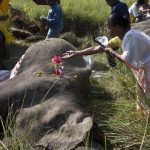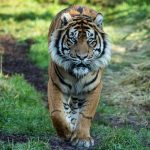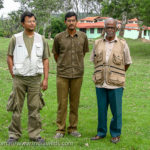Endangered Wild Buffalo of Kaziranga
One of the most endangered wild animals in Kaziranga is the Wild Buffalo. Growing upto 1200 kgs, they roam free in the 430 square kilometer area of the Kaziranga National Park. Some 1400 of them survive here. A few wild buffalos are also found in Chhatishgarh. In the past there have been some sightings of Wild Buffalo in Meghalaya, Maharashtra and Sunabeda Wildlife Sanctuary in Odisha.
Wild buffalos are herbivorous animals. Their regular diet includes aquatic plants, crops, grasses, herbs, leaves, bark of trees. They feed on aquatic vegetation that grows in marshy areas and along rivers and also eat microalgae and stems. Wild buffaloes are also important to the grassland ecosystem as they help in plant rejuvenation.
Both the males and females have horns. Their horns are heavy at the base with a wide sweep spreading up to 2 meters along the outer edges. With these impressive set of horns they look majestic. These aren’t just for show; they are vital tools for defense and dominance within their herds.
From their demeanour they don’t appear to have a good impression about people as more often they start snorting, kicking the ground with their hoofs and charging. If you are on foot, then it would be prudent to keep a safe distance from these giant herbivores.
This Wild Buffalo with an impressive set of horns came close to my jeep. We were on higher ground. I was quietly filming and no one moved. Finally it decided against charging at us.
Wild Buffalos are polygynous. One male mates with multiple females. The dominant male mates with females of the clan, after which the male is driven away by them. The breeding season is from October to November. The gestation period is 11 months, after which a single calf is born. The newborn calf weighs between 35-40 kilograms. Calves are nursed for 9 months. When the mother is with the calf, she resents the sight of any predators and people. She shakes her head as if she is shoving and hitting out at the source of danger. Some feral dogs appeared at a distance and the mother immediately turned around to face in their direction. Even though the feral dogs were running away, as a mother she is always on high alert. She is not going to take any chances.
The calf becomes independent in 2 years. Male buffaloes reach reproductive maturity at the age of 1.5 years while females do at the age of 3 years.
These wild buffalos can cross breed with domestic buffalos. When the female wild buffalo gets pregnant by a domestic buffalo the calf survives. But when a male wild buffalo impregnates a female domestic buffalo then it becomes difficult as the domestic buffalo is not designed to carry a large sized baby of the wild buffalo. Cross breeding is an issue around the periphery of Kaziranga. It is a big issue for the wild buffalos of Chhattisgarh as their genetic purity is questionable.
Despite their tough exterior and fierce reputation, buffalos are social animals. They live in herds led by a dominant female and demonstrate complex social behaviors.
As the Sun started hiding below the horizon, suddenly we witnessed a marvellous sight. Hundreds of wild buffalos started trooping in. The entire place was teeming with these majestic wild buffalos. They were congregating at one spot, gathering to rest.
Wild Buffalos are protected under the Wildlife (Protection) Act 1972. Poaching and habitat loss due to encroachment is a big challenge. The International Union for Conservation of Nature (IUCN) has classified the animal as endangered in its red list of threatened species.
The future of these Wild Buffalos are intertwined with the fate of Kaziranga. It reminds us of the importance of preserving such natural wonders.
- Endangered Wild Buffalo of Kaziranga - 4 July,2024
- Leopards: The Last Stand Trailer 2 - 1 July,2024
- GoPro Hero 12 Black - 6 September,2023











Leave a Reply